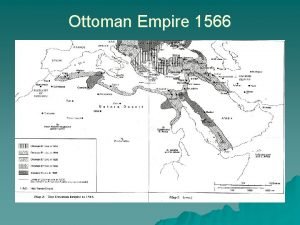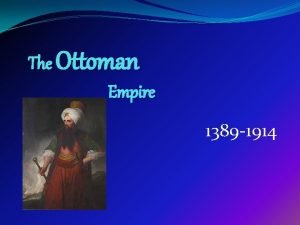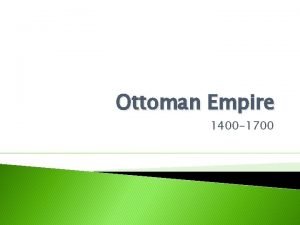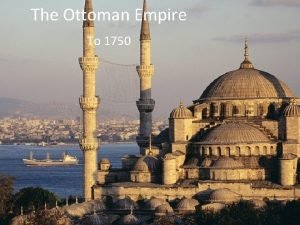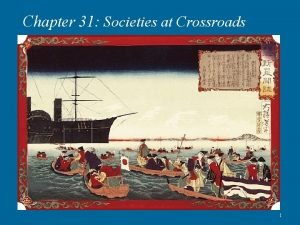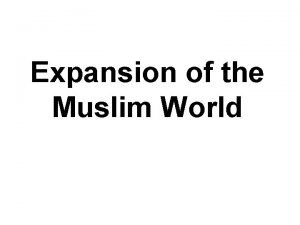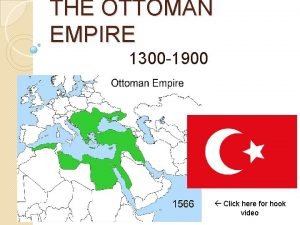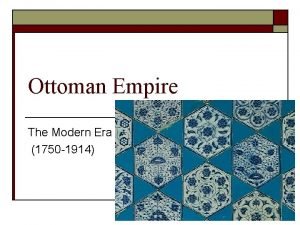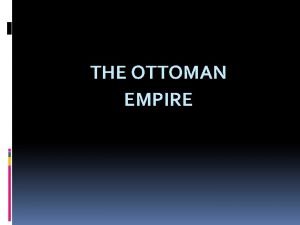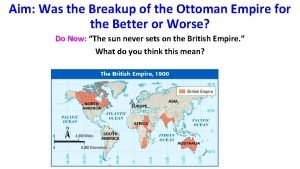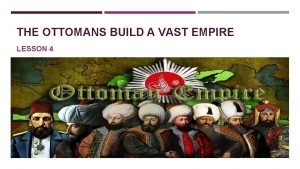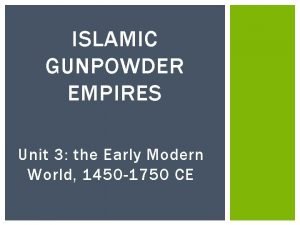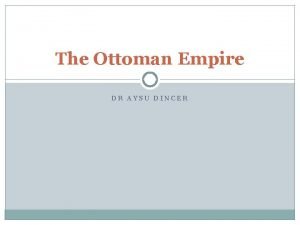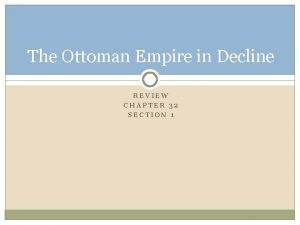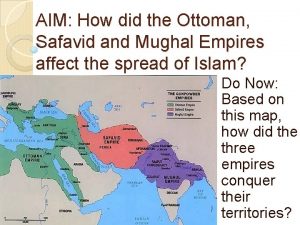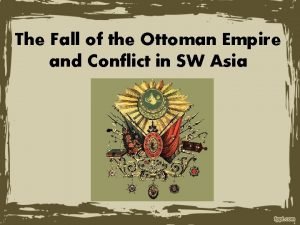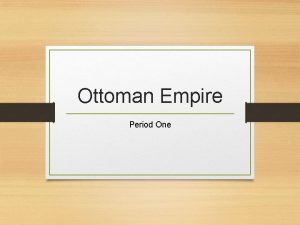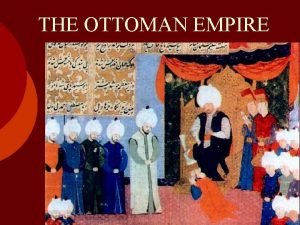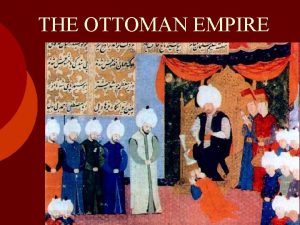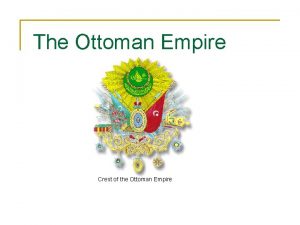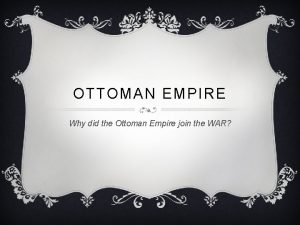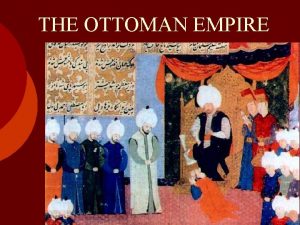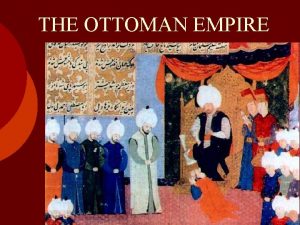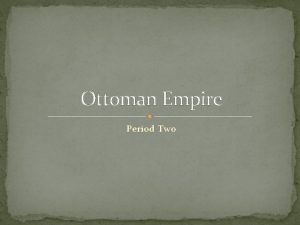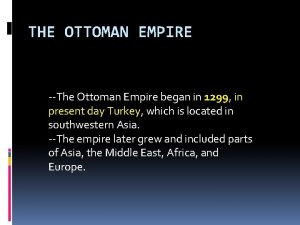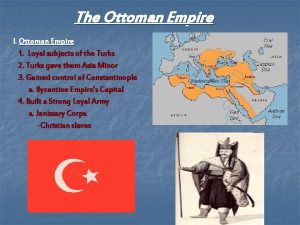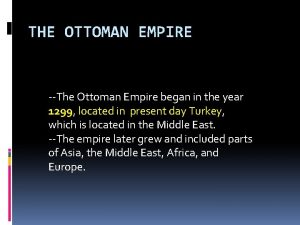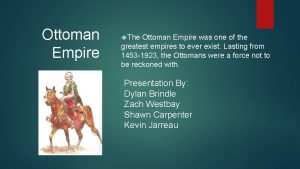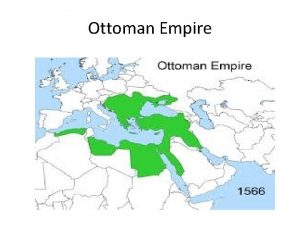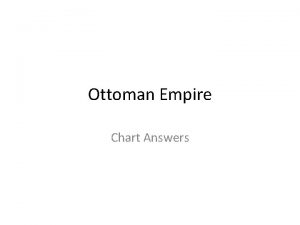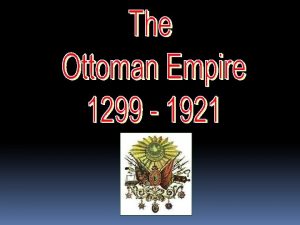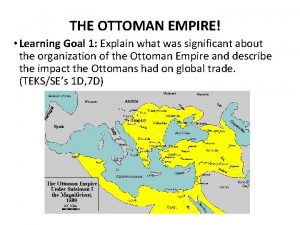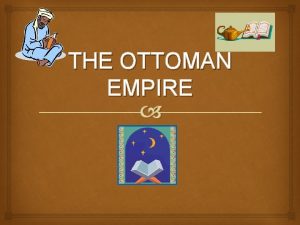The Ottoman Empire The Ottoman Empire Existed from

























- Slides: 25


The Ottoman Empire

The Ottoman Empire • Existed from 1281 to 1923 • one of the largest empires to rule the borders of the Mediterranean Sea • Rivaled China in size and economic power • reached its apex under Suleiman I • 16 th and 17 th centuries • among the world's most powerful political entities • Countries of Europe felt threatened by its steady advance • organization • sultan in the top • below his viziers, other court officials, and military commanders. • A vizier is a high ranking political and/or religious official

Height of the Ottoman Empire • Suleyman the Magnificent • Reigned from 1520 - 1566 • Expanded the Ottoman Empire from the gates of Vienna to the Persian Gulf • Siege of Vienna • First failed campaign for Ottomans • Brought coffee to the Europeans • Source of musical, theatrical, and cultural growth for Europe as it interacted with Islamic culture • Claimed the role of Caliph of Islam was held by the Ottoman Sultan

Why Did The Ottomans Succeed? • Ottomans tolerated other faiths— didn’t fight wars of religious exclusivism • Many in Old Byzantine Empire weary of corruption in Byzantine state

The “Sick Man” of Europe • Decline in power • Young Turk Nationionalism • World War I • Wrong choice

Jannisaries: Ottoman Special Forces

Who were they? • Ottomans • From the Turkish term yeniceri • First organized by bey Murad I in the late 14 th Century • 7 – 14 year old Christian(non-Muslim) boys kidnapped • Devsirme (“labor tax”) • Why is Christian a big deal

Who were they? (cont’d) • Later converted to Islam • Christians couldn’t carry weapons in the Ottoman Empire • Initially, most from Balkan regions (specifically Greece) • Forced to maintain a higher moral standard • Initially forced to be celibate and no beards • 16 th Century – Marriage becomes acceptable • Beards were a sign of freedom

Issues • Staged Coups • Wanted more $$, more rights (marriage), • 1622 – Killed sultan Osman II • Expensive • Maintained their own trades and became a “state within a state” • 1826 – Sultan eliminates Janissaries • Either killed or exiled

Safavid Empire 1501 - 1722

Founding and Religious Identities • From Persia to Afghanistan • Founded by Safi al-Din • A sufi mystic and 1 st ruler of the dynasty • (1322) • Empire marked by continual clashes with other Muslim powers • 1399 – Empire becomes Shi’a

The Safavids: Turkish conquerors of Persia and Mesopotamia • Shah Ismail (reigned 1501 -1524) • Claims ancient Persian title of shah. • Proclaimed Twelver Shiism the official religion; imposed it on Sunni population • Followers known as qizilbash (or "Red Hats/Heads") • Twelver Shiism • Traced origins to twelve ancient Shiite imams • Ismail believed to be the twelfth, or "hidden, " imam, or even an incarnation of Allah

Battle of Chaldiran - 1514 • Sunni Ottomans persecuted Shiites within Ottoman empire • Chaldiran today is in Azerbaijan • Ottoman/Janissary forces • modern weapons (guns…) • Safavid/Qizilbash forces • considered firearms unmanly though they did have some • Results • Safavids crushed by Ottomans • Establishes border between Iran and Turkey • STRESSES IMPORTANCE OF GUNS

Shah Abbas the Great • (1588 -1629) • revitalized the Safavid empire • Territorial Expansion • Modernized military; sought European alliances against Ottomans • new capital at Isfahan • centralized administration • Post-Shah Abbas • Steady decline

The Great Mughal Empire 1526 -1707

Introduction • Under the Mughals, India was the heart of a great Islamic empire and a prolific center of Islamic culture and learning. • Dynasty was the greatest, richest and longest lasting Muslim dynasty to rule India. • Mongol Descendents • The Great Mughal Emperors were: • Babur (1526 -1530) The First of the Mughals • Humayun (1530 -1556) The Luckless Leader • Akbar (1556 -1605) The Great • Jehangir (1605 -1627) The Paragon of Stability • Shah Jehan (1627 -1658) The Master Builder • Aurangzeb (1658 -1707) The Intolerant

Babur 1526 - 1530 The First of the Mughals • Babur was a direct descendant of the Turkish Ghengis Khan Timur from Tamerlane. and • Defeated the Delhi Sultanate & established the Mughal Empire. • Gunpowder, a skilled commander, trained soldiers on horses contributed to the victory • Gained control of the whole northern India • Made Agra capital • He reigned for 4 short years and died at age 47 in 1530. • Did not enact new laws or organization in the empire due to early his death

Humayun 1530 - 1556 The Luckless Leader • After Babur died, he was succeeded by his son Humayun in 1530. Humayun was 23 years old. • He was not a soldier and unlike his father, neither skilled nor a wise leader. • Inherited a disunited and disorganized empire. • In 1540, Sher Shah of Bengal defeated Humayun and took over the Mughal Empire. The Empire was lost from 1540 -1545. • He was exiled but later regained power in 1555. • Humayun died in 1556 after falling down the steps of his library; he is known as “the luckless one”.

Akbar 1556 - 1605 The Great • Akbar become the new Mughal ruler at the age of 14. • Regent and his mother ruled in his name for 4 years • Akbar was an ambitious and noble commander • Built the largest army ever in the empire. • Helped to conquer nearly all of modern-day northern India and Pakistan. • Great administrator • developed a centralized government • It delegated 15 provinces each under a governor and each province into districts and each district was further sub-divided into smaller sections. • Best known for tolerance of his subjects (especially Hindus) • Removed poll taxes on Hindus • Invited religious scholars to debate him in his private chambers. • Developed his own faith call Din Ilahi. • Din Ilahi was a mixture of the other religions Akbar had studied from those debates. • Religion never caught on

Jehangir 1605 - 1627 The Paragon of Stability • Jehangir succeeded his father Akbar in 1605. • Opposite of his father • Poor monarch and warrior but good at maintaining the status quo. • He continued many of Akbar’s policies. • • Freedom of worship. Fair treatment of Hindus. Continued friendship and alliance with Rajputs. Allowed foreigners like the Portuguese and English into India for trade. • Jehangir married Nur Jahan. She became the real ruler of the empire until the death of her husband.

Jehangir Issues (specific) • Under the influence of his wife and many others, Jehangir was not an able ruler like his father. • He loved to drink and enjoy himself. • He had to suppress many rebellions. • Important posts in the court were given to families, friends, and especially those close to his wife, Jahan.

Shah Jehan 1627 - 1658 The Master Builder • Shah Jehan succeeded his father in 1627. • Better ruler than Jehangir. • • Restored the efficiency of government. Recovered territories. Maintained peace Foreign traders were allowed into India and trade increased considerably. • The empire was expanded. • Shah Jehan was a patron of the arts • Built many great architecture buildings including the Taj Mahal and the Peacock Throne, a brilliant gold throne encased in hundreds of precious gems.

Shah Jehan • Taj Mahal • Built in honor of his wife who died during childbirth. • Took over a decade to build and it nearly bankrupted the empire. • 1657 - Shah Jehan became seriously ill and a dispute over the succession of the throne ensued between his three sons. • Aurangzeb deposed Shah Jehan in a coup d’etat in 1658. Shah Jehan was imprisoned in the Octagonal Tower of the Agra Fort from which he could see the Taj Mahal. He died in 1666 and was buried next to his wife in the Taj Mahal.

Aurangzeb 1658 - 1707 The Intolerant • Aurangzeb ascended the throne after disposing his father and beating out his two brothers. • Despot • severely persecuted Hindus of Northern India. • Empire declines under his reign • He removed the tax-free status for Hindus • Destroyed their temples • Crushed semi-autonomous Hindu states • Primary Interest - Promote Islam vs tolerance
 A broad lowland area north of the carpathians
A broad lowland area north of the carpathians What types of homes existed in salem
What types of homes existed in salem Gunpowder empires map
Gunpowder empires map Ottoman empire 1566
Ottoman empire 1566 Was the ottoman empire tolerant of other religions
Was the ottoman empire tolerant of other religions Ottoman empire
Ottoman empire Ottoman empire 1400
Ottoman empire 1400 Ottoman empire 1815
Ottoman empire 1815 Map of ottoman empire
Map of ottoman empire Map of ottoman empire 1800
Map of ottoman empire 1800 Suleiman the magnificent expansion
Suleiman the magnificent expansion Saltanat e usmania map
Saltanat e usmania map Ottoman empire 1914
Ottoman empire 1914 Ottoman safavid and mughal empire map
Ottoman safavid and mughal empire map Ottoman empire vocabulary
Ottoman empire vocabulary The ottoman empire grew and expanded after it conquered the
The ottoman empire grew and expanded after it conquered the Breakup of the ottoman empire
Breakup of the ottoman empire Jagadai khanate
Jagadai khanate Chapter 26 civilizations in crisis the ottoman empire
Chapter 26 civilizations in crisis the ottoman empire Ottoman empire at its height
Ottoman empire at its height The ottomans build a vast empire
The ottomans build a vast empire How big was the islamic empire
How big was the islamic empire Ottoman empire balkan
Ottoman empire balkan Map of ottoman empire 1800
Map of ottoman empire 1800 Ottoman safavid and mughal empire map
Ottoman safavid and mughal empire map Ottoman empire 1914
Ottoman empire 1914



